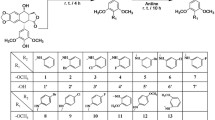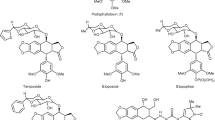Abstract
In previous work, we presented experimental and theoretical evidence that podophyllum derivatives substituted by chlorine atom in the 3-posititon of 2-aminopyridine exhibited significantly elevated potency. In this study, a series of podophyllum derivatives substituted in the 3-position of 2-aminopyridine, including methyl and fluorine groups, were synthesized. Their chemical structures were confirmed by the spectral (1H-nuclear magnetic resonance, 13C-nuclear magnetic resonance, electrospray ionization mass spectrometry) and elemental analyses. These derivatives were tested for their respective cytotoxicities in HeLa, BGC-823, A549, Huh7, and MCF-7 cells by MTT assay and the pharmacological results showed that most of them displayed potent cytotoxicities against at least one of the tested cancer cell lines. Structure–activity relationship study suggested that the introduction of the fluorine atom into the 3-posititon of 2-aminopyridine had enhanced the cytotoxicity against numerous tumor cells compared to the chlorine atom, while the methyl group did not. Furthermore, other biological experiments were consistent with the beneficial effect of fluorine atom substituent in the 3-position of 2-aminopyridine, which then inhibited the microtubule polymerization and activity of topoisomerase II when 2-amino-3-fluoropyridine substituted in podophyllotoxin and 4′-O-demethylepipodophyllotoxin, and that they work by effecting the target proteins which induce P53-dependent apoptosis.







Similar content being viewed by others
Change history
28 November 2018
The corrected version of the figure including P53 expression appears below. This correction does not change any conclusions of the paper.
28 November 2018
The corrected version of the figure including P53 expression appears below. This correction does not change any conclusions of the paper.
References
Abdur Rauf SM, Takaba H, Del Carpio CA, Miyamoto A (2014) How nutlin-3 disrupts the MDM2-p53 interaction: a theoretical investigation. Med Chem Res 23:1998–2006
Baldwin EL, Osheroff N (2005) Etoposide, topoisomerase II and cancer. Curr Med Chem Anticancer Agents 5:363–372
Bhat BA, Reddy PB, Kumar-Agrawal S, Saxena AK, Sampath-Kumar HM, Qazi GN (2008) Studies on novel 4β-[(4-substituted)-1,2,3-triazol-1-yl] podophyllotoxins as potential anticancer agents. Eur J Med Chem 43:2067–2072
Bhattacharyya D, Hazra S, Banerjee A, Datta R, Kumar D, Chakrabarti S, Chattopadhyay S (2016) Transcriptome-wide identification and characterization of CAD isoforms specific for podophyllotoxin biosynthesis from Podophyllum hexandrum. Plant Mol Biol 92:1–23
Bohrin L, Rosen B (1996) Drug discovery and development. Drug Discov Today 1:343–351
Castro MA, Corral JM, Gordaliza M, Garcia PA, Zurita MA, Feliciano AS (2004) Synthesis and biological evaluation of new selective cytotoxic cyclolignans derived from podophyllotoxin. J Med Chem 47:1214–1222
Chang H, Shyu HG, Lee CC, Tsai SC, Wang BW, Lee YH, Lina S (2003) GL331 inhibits HIF-1α expression in a lung cancer model. Biochem Biophys Res Commun 302:95–100
Chashoo G, Singh SK, Sharma PR, Mondhe DM, Hamid A, Saxena A, Andotra SS, Shah BA, Qazi NA, Taneja SC, Saxena AK (2011) A propionyloxy derivative of 11-keto-β-boswellic acid induces apoptosis in HL-60 cells mediated through topoisomerase I & II inhibition. Chem Biol Interact 189:60–71
Chu DT, Fernandes PB (1989) Structure–activity relationships of the fluoroquinolones. Antimicrob Agents Chemother 33:131–135
Daley L, Meresse P, Bertounesque E, Monneret C (1997) A one-pot, efficient synthesis of the potent cytotoxic podophyllotoxin derivative NPF. Tetrahedron Lett 38:2673–2676
Hao C, Gao LX, Zhang YR, Wang W, Yu GL, Guan HS, Zhang LJ, Li CX (2015) Acetylated chitosan oligosaccharides act as antagonists against glutamate-induced PC12 cell death via Bcl-2/Bax signal pathway. Mar Drugs 13:1267–1289
Hu CQ, Xu DQ, Du WT, Qian SJ, Wang L, Lou JS, He QJ, Yang B, Hu YZ (2010) Novel 4β-anilino- podophyllotoxin derivatives: design synthesis and biological evaluation as potent DNA- topoisomerase II poisons and anti-MDR agents. Mol BioSyst 6:410–420
Jin ZG, Shen JF, He JY, Hu CQ (2015) Combination therapy with p53-MDM2 binding inhibitors for malignancies. Med Chem Res 24:1369–1379
Jordan MA, Thrower D, Wilson L (1992) Effects of vinblastine, podophyllotoxin and nocodazole on mitotic spindles. Implications for the role of microtubule dynamics in mitosis. J Cell Sci 102:401–416
Kamal A, Arifuddin M, Dastidar SG, Kumar BA (2003a) Synthesis of 4β-amido and 4β-sulphonamido analogues of podophyllotoxin as potential antitumour agents. Bioorg Med Chem 11:5135–5142
Kamal A, Gayatri NL, Reddy DR, Mohan-Reddy PS, Arifuddin M, Dastidar SG, Kondapi AK, Rajkumar M (2005) Synthesis and biological evaluation of new 4β-anilino- and 4β-imido-substituted podophyllotoxin congeners. Bioorg Med Chem 13:6218–6225
Kamal A, Kumar BA, Arifuddin M (2003b) A one-pot, efficient and facile synthesis of 4β- arylaminopodophyllotoxins: synthesis of NPF and GL-331 as DNA topoisomerase II inhibitors. Tetrahedron Lett 44:8457–8459
Kamal A, Kumar BA, Suresh P, Juvekar A, Zingde S (2011a) Synthesis of 4β-carbamoyl epipodophyllotoxins as potential antitumour agents. Bioorg Med Chem 19:2975–2979
Kamal A, Kumar BA, Suresh P, Shankaraiah N, Kumar MS (2011b) An efficient one-pot synthesis of benzothiazolo-4β-anilino-podophyllotoxin congeners: DNA totopoisomerase-II inhibition and anticancer activity. Bioorg Med Chem Lett 21:350–353
Kamal A, Lakshmi-Gayatri N (1996) An efficient method for 4β-anilino-4′-demethylepipodophyllotoxins: synthesis of NPF and W-68. Tetrahedron Lett 37:3359–3362
Kaufmann SH, Earnshaw WC (2000) Induction of apoptosis by cancer chemotherapy. Exp Cell Res 256:42–49
Kim ND, Yoon J, Kim JH, Lee JT, Chen YS, Hwang MK, Ha L, Song W (2006) Putative therapeutic agents for the learning and memory deficits of people with Down syndrome. Bioorg Med Chem 15:3772–3776
Knudsen KE, Booth D, Naderi S, Sever-chroneos Z, Fribourg AF, Hunton IC, Feramisco JR, Wang JY, Knudsen ES (2000) RB-dependent S-phase response to DNA damage. Mol Cell Biol 20:7751–7763
Lakhani SA, Masud A, Kuida K, Porter-Jr GA, Booth CJ, Mehal WZ, Inayat I, Flavell RA (2006) Caspases 3 and 7: key mediators of mitochondrial events of apoptosis. Science 311:847–851
Lee KH, Beers SA, Mori M, Wang ZQ, Kuo YH, Li L, Liu SY, Chang JY, Han FS, Chen YC (1990) Antitumor agents. 111. New 4-hydroxylated and 4-halogenated anilino derivatives of 4′-demethylepipodophyllotoxin as potent inhibitors of human DNA topoisomerase II. J Med Chem 33:1364–1368
Liu J, Li Y, Ren W, Hu WX (2006) Apoptosis of HL-60 cells induced by extracts from Narcissus tazetta var. chinensis. Cancer Lett 242:133–140
Liu YQ, Tian J, Qian K, Zhao XB, Morris-Natschke SL, Yang L, Nan X, Tian X, Lee KH (2015) Recent progress on C-4-modified podophyllotoxin analogs as potent antitumor agents. Med Res Rev 35:1–62
Liu YQ, Wei DF, Zhao YL, Cheng WD, Lu Y, Ma YQ, Li X, Han C, Wei YX, Cao HM, Zhao CY (2012) Synthesis and biological evaluation of a series of podophyllotoxin derivatives as a class of potent antitubulin agents. Bioorg Med Chem 20:6285–6295
Lu YX, Shi T, Wang Y, Yang HY, Yan XH, Luo XM, Jiang HL, Zhu WL (2009) Halogen bonding-a novel interaction for rational drug design? J Med Chem 52:2854–2862
Nitiss JL (2009) Targeting DNA topoisomerase II in cancer chemotherapy. Nat Rev Cancer 9:338–350
Passarellla D, Giardini A, Petretto B, Gabriele F, Sacchetti A, Silvani A, Ronchi C, Cappelletti G, Caetelli D, Blorlak C, Danieli B (2008) Inhibitors of tubulin polymerization: synthesis and biological evaluation of hybrids of vindoline, anhydrovinblastine and vinorelbine with thiocolchicine, podophyllotoxin and baccatin III. Bioorg Med Chem 16:6269–6285
Pitts SL, Jablonksy MJ, Duca M, Dauzonne D, Monneret C, Adrimondo PB, Anklin C, Graves DE, Oscheroff N (2011) Contributions of the D-ring to the activity of etoposide against human topoisomerase IIα: potential interactions with DNA in the ternary enzyme-drug-DNA complex. Biochemistry 50:5058–5066
Pugazhenthi S, Nesterova A, Sable C, Heidenreich KA, Boxer LM, Heasley LE, Reusch JE (2000) Akt/protein kinase B up-regulates Bcl-2 expression through cAMP-response element-binding protein. J Biol Chem 275:10761–10766
Qi SN, Jing YX, Dong GX, Chen Y, Yoshida A, Ueda T (2007) GP7 induces internucleosomal DNA fragmentation independent of caspase activation and DNA fragmentation factor in NB4 cells. Oncol Rep 18:273–277
Reddy DM, Srinivas J, Chashoo G, Saxena AK, Sampath-Kumar HM (2011) 4β-[(4-Alkyl)-1,2,3-triazol- 1-yl] podophyllotoxins as anticancer compounds: design, synthesis and biological evaluation. Eur J Med Chem 46:1983–1991
Ren J, Wu L, Xin WQ, Chen X, Hu K (2012) Synthesis and biological evaluation of novel 4β-(1,3,4- oxadiazole-2-amino)-podophyllotoxin derivatives. Bioorg Med Chem Lett 22:4778–4782
Tang YJ, Wang H, Zhao W, Li HM (2014) Preparation method and application of nitrogen substituted podophyllum derivates with antitumor activity. China Patent CN 103601732A
Thurston LS, Imakura Y, Haruna M, Li DH, Liu ZC, Liu SY, Cheng YC, Lee KH (1989) Antitumor agents. 100. Inhibition of human DNA topoisomerase II by cytotoxic ether and ester derivatives of podophyllotoxin and alpha-peltatin. J Med Chem 32:604–608
Van-Vilet DS, Tachibana Y, Bastow KF, Huang ES, Lee KH (2001) Antitumor agents. 207.1 design, synthesis, and biological testing of 4β-Anilino-2-fluoro-4′-demethylpodophyllotoxin analogues as cytotoxic and antiviral agents. J Med Chem 44:1422–1428
Wang H, Tang LJ, Tang YJ, Yuan ZP (2014) SAR analysis and biological studies of synthesized podophyllum derivates obtained by N linkage modification at C-4 position. Bioorg Med Chem 22:6183–6192
Xiao ZY, Xiao YD, Feng J, Golbraikh A, Tropsha A, Lee KH (2002) Antitumor agents. 213. Modeling of epipodophyllotoxin derivatives using variable selection k nearest neighbor QSAR method. J Med Chem 45:2294–2309
Zhang L, Chen F, Wang J, Chen YZ, Zhang ZQ, Lin Y, Zhu XL (2015) Novel isatin derivatives of podophyllotoxin: synthesis and cytotoxic evaluation against human leukaemia cancer cells as potent anti-MDR agents. RSC Adv 5:97816–97823
Zhang YX, Zhao W, Tang YJ (2016) Multilevel induction of apoptosis by microtubule-interfering inhibitors 4β-S-aromatic heterocyclic podophyllum derivatives causing multi-fold mitochondrial depolarization and PKA signaling pathways in HeLa cells. Oncotarget 7:24303–24313
Zhao W, Yang Y, Zhang YX, Zhou C, Li HM, Tang YL, Liang XH, Chen T, Tang YJ (2015) Fluoride-containing podophyllum derivatives exhibit antitumor activities through enhancing mitochondrial apoptosis pathway by increasing the expression of caspase-9 in HeLa cells. Sci Rep 5:17175. doi:10.1038/srep17175
Zhao Y, Hui J, Wang D, Zhu L, Fang JH, Zhao XD (2010) Synthesis, cytotoxicity and pro-apoptosis of novel benzoisoindolin hydrazones as anticancer agents. Chem Pharm Bull 58:1324–1327
Zhou XM, Wang ZQ, Chang JY, Chen HX, Cheng YC, Lee KH (1991) Antitumor agents. 120. New 4-substituted benzylamine and benzyl ether derivatives of 4′-O-demethylepipodophyllotoxin as potent inhibitors of human DNA topoisomerase II. J Med Chem 34:3346–3350
Zhu XK, Guan J, Tachibana Y, Bastow KF, Cho SJ, Cheng HH, Cheng YC, Gurwith M, Lee KH (1999) Antitumor agents. 194. synthesis and biological evaluations of 4-β-mono-, -di-, and -trisubstituted aniline-4′-O-demethyl-podophyllotoxin and related compounds with improved pharmacological profiles. J Med Chem 42:2441–2446
Zhu XK, Guan J, Xiao ZY, Cosentino LM, Lee KH (2004) Anti-AIDS agents. Part 61: anti-HIV activity of new podophyllotoxin derivatives. Bioorg Med Chem 12:4267–4273
Acknowledgements
This work was supported by Science and Technology Youth Project of Education Department in Jiangxi province (NO. GJJ150109). I would like to acknowledge and thank the professors (Yajie Tang, Hubei University of Technology; Zhanpeng Yuan, Wuhan University) for their essential help. I also wish to thank the editor, the associate editor, and those anonymous reviewers for their helpful comments and suggestions, which have led to an improvement of this article.
Author information
Authors and Affiliations
Corresponding author
Ethics declarations
Conflict of interest
The author declares that they have no competing interests.
Electronic supplementary material
Rights and permissions
About this article
Cite this article
Wang, H. Podophyllum derivatives containing fluorine atom in the 3-position of 2-aminopyridine improved the antitumor activity by inducing P53-dependent apoptosis. Med Chem Res 26, 1279–1290 (2017). https://doi.org/10.1007/s00044-017-1841-x
Received:
Accepted:
Published:
Issue Date:
DOI: https://doi.org/10.1007/s00044-017-1841-x




